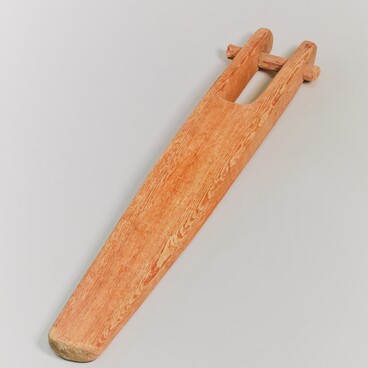The Khanty, a small indigenous people, live on the territory of the Khanty—Mansi Autonomous Area. From ancient times they believed in spirits and worshiped them. The Museum of the Ob River houses a copy of the Ai-ega-iki sanctuary, which belonged to the Khanty family — the Sovkunins. Ai-ega-iki is a legendary bogatyr (hero), an owner, and a keeper of the Maly Salym. He has many names, but Ai-ort-iki (“a small bogatyr”) and Ai-ega-iki (“a man of a small river”, “a river owner”) are the most common. It is believed that this leader received his last name at an old age.
The spiritual pantheon of the Salym Khanty is extensive: it includes patrimonial heroes of the fishing cult, and personal, family patron spirits, and tonkhs — patrons of individual territories.
The sanctuary of Ai-ega-iki was located near the Sovkunins’ winter yurts on the Ai-ega River, which flows into the Maly Salym River. People found out about the sacred place in the 18th century when the first sacred “barn”, the earthly house of the tonkhs, was erected there, and their wooden images were made. The Khanty brought their gifts to this place to appease the spirits.
Researchers from the Nefteyugansk District saw this monument of Ugrian culture already in a deplorable state. The reason was that in 1968, a worker of geophysical expeditions stole offerings from the sanctuary to the tonkhs: arrowheads, ancient coins, furs. After the desecration, the sanctuary fell into disrepair; the local population considered that the idols had lost their former power. Gradually, without proper attention and care, the barn partially rotted and collapsed.
The interior was reconstructed according to the preserved components and information provided by the Sovkunins. Researchers found out that the wooden sculptures had been located at the back of the eastern wall. There was a 2.6 meters high statue of Ai-ega-iki in the center. On his right hand, there was a 1.7 meters high sculpture of his wife Sav-yakh-imi. There was Sav-yakh-iki, about a meter high, after her. He is considered to be a father-in-law of Ai-ega-iki and the keeper of the Sav-yakh river. As-sotym-panen-iki and As-sotym-panen-imi were patrons of summer fishing. They were located to the left of the pantheon head. A sculpture of the keeper of the sacred barn and the surrounding area — Vont-kar-im was placed separately on the shelf. The height of the figure was only 60 centimeters.
The idols in the Museum of the Ob River are exact copies of the statues from the sacred barn of the Sovkunins. The sculptures are carved from a single tree trunk. Male and female tonkhs images differ. The male spirits are massive, slightly angular; their heads have a cylindrical shape. The female spirits are made more elegantly and with rounded heads. Despite the fact that researchers restored the barn and renewed wooden tonkhs, the sanctuary remained abandoned.
The spiritual pantheon of the Salym Khanty is extensive: it includes patrimonial heroes of the fishing cult, and personal, family patron spirits, and tonkhs — patrons of individual territories.
The sanctuary of Ai-ega-iki was located near the Sovkunins’ winter yurts on the Ai-ega River, which flows into the Maly Salym River. People found out about the sacred place in the 18th century when the first sacred “barn”, the earthly house of the tonkhs, was erected there, and their wooden images were made. The Khanty brought their gifts to this place to appease the spirits.
Researchers from the Nefteyugansk District saw this monument of Ugrian culture already in a deplorable state. The reason was that in 1968, a worker of geophysical expeditions stole offerings from the sanctuary to the tonkhs: arrowheads, ancient coins, furs. After the desecration, the sanctuary fell into disrepair; the local population considered that the idols had lost their former power. Gradually, without proper attention and care, the barn partially rotted and collapsed.
The interior was reconstructed according to the preserved components and information provided by the Sovkunins. Researchers found out that the wooden sculptures had been located at the back of the eastern wall. There was a 2.6 meters high statue of Ai-ega-iki in the center. On his right hand, there was a 1.7 meters high sculpture of his wife Sav-yakh-imi. There was Sav-yakh-iki, about a meter high, after her. He is considered to be a father-in-law of Ai-ega-iki and the keeper of the Sav-yakh river. As-sotym-panen-iki and As-sotym-panen-imi were patrons of summer fishing. They were located to the left of the pantheon head. A sculpture of the keeper of the sacred barn and the surrounding area — Vont-kar-im was placed separately on the shelf. The height of the figure was only 60 centimeters.
The idols in the Museum of the Ob River are exact copies of the statues from the sacred barn of the Sovkunins. The sculptures are carved from a single tree trunk. Male and female tonkhs images differ. The male spirits are massive, slightly angular; their heads have a cylindrical shape. The female spirits are made more elegantly and with rounded heads. Despite the fact that researchers restored the barn and renewed wooden tonkhs, the sanctuary remained abandoned.



